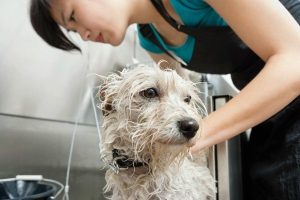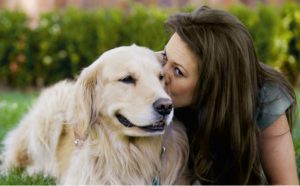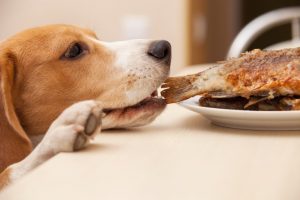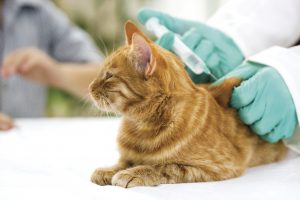Posts Tagged ‘new animal’
Dr. Olsen’s Breed Spotlight: Pixie-Bob Cat
 Dogs are considered “man’s best friend.” But what do you get when you don’t have room or time for a dog? How about a cat that thinks it’s a dog? The breed of cat that I am spotlighting this month has been described as that. It is called the Pixie-Bob.
Dogs are considered “man’s best friend.” But what do you get when you don’t have room or time for a dog? How about a cat that thinks it’s a dog? The breed of cat that I am spotlighting this month has been described as that. It is called the Pixie-Bob.
The Pixie-Bob breed is thought to be the result of the natural mating between a bobcat and a domestic shorthair, but they may also have sprung from a natural genetic mutation that gave them their wild look and bobbed tail. It is one of those mysteries that no one will ever know for sure. This breed was first developed in the Pacific Northwest in the mid 1980’s by a woman that acquired a male kitten with distinctive characteristics like a spotted coat, a short tail and more than usual numbers of toes. A year later, she acquired another male cat with a short tail and with the help of a neighbor’s female cat, produced a litter of kittens. One, a female, had a muted spotted pattern and the woman kept her—naming her Pixie. The breeder wanted more cats like Pixie, and soon the breed was born. They were recognized as an actual breed by the American Cat Fanciers Association in 2005.
Pixie-Bobs are described as “big, lively and outgoing.” The breeds’ devotion to its family belies its somewhat wild look. They tend to be a large cat where the male and female can weigh up to 12 and 25 pounds respectively. They are brawny and muscular which is why some breeders believe that the Coastal Red Bobcat had to be the founding father. Their ears tend to be tufted and resemble that of a bobcat by having lynx tips on the ears. Pixie-Bobs have a thick wooly coat like a bobcat and can be either long or short haired. They normally have a striped coat pattern and come in a variety of colors, but most are tawny, light gray, or reddish. Their eye color can be from golden brown to gooseberry green. A Pixie-Bob’s tail is a minimum of 2 inches by can be as long as to their hock. Their facial hair grows downward giving them the appearance of a man’s muttonchop sideburns. One other unique feature that some Pixie-Bobs have are that some are polydactyl. This means that they have more than the usual number of digits on its paws. Polydactyl cats are considered lucky, so if you own a Pixie-Bob, luck may be on your side.
Pixie-Bobs are inquisitive and like to interact with families, so they are true companions and members of the family because of their relaxed attitude. They communicate with their families with a pleasant voice and standard meows and purrs. They are active and enjoy being friends. They enjoy interaction with families and have been described by some as “the cat that thinks it is a dog.” Pixie-Bobs love going on car rides and walks just like dogs. They also get along well with dogs and other pets. Because they tend to be a medium to long haired breed, they do require a weekly brushing to prevent mattes from forming and regular nail trims.
If you have a Pixie-Bob cat or even a good ol’ domestic shorthair, the Olsen Veterinary Clinic tries to meet the expectations for all of your pet’s needs. If you have any questions or issues please do not hesitate to call us at (618)-656-5868.
How To Remove Tree Sap From Your Dog’s Fur
 Dogs seem to get into ugly predicaments during the summer. If they like to wander, sometimes they may come back with that sticky tree sap that can cause debris like rocks or pine needles to stick to their paws. This can sometimes be quite painful and it leads to an owner figuring out how to remove the sap from your pet. Some types of sap can be toxic if ingested or cause irritation if it comes in contact with your pet’s skin, so it is important to work quickly to remove it.
Dogs seem to get into ugly predicaments during the summer. If they like to wander, sometimes they may come back with that sticky tree sap that can cause debris like rocks or pine needles to stick to their paws. This can sometimes be quite painful and it leads to an owner figuring out how to remove the sap from your pet. Some types of sap can be toxic if ingested or cause irritation if it comes in contact with your pet’s skin, so it is important to work quickly to remove it.
Fortunately, removing tree sap is an easy process and can be done using common household items. Below are some steps that I recommend to remove sap from the fur.
- If the sap is hardened, it will need to be softened using a hair dryer set on its lowest setting. Test the dryer first with your hand to find a safe distance where the air feels warm but not hot.
- Loosen the sap by using olive oil, mineral oil, or smooth peanut butter. Massage the product onto the affected fur and let it sit a few minutes. It is important to only use products that are safe if ingested, since your pet may try to lick the oily substance off its fur.
- Use your fingers and a wide-tooth comb to carefully and slowly work the sap out of your pet’s fur. As you go, you can wipe some of the oily product and residue with a washcloth or paper towel.
- If there are stubborn patches near the tips of the hair, you can carefully trim them with a scissors, making sure to avoid cutting too close to the skin.
- Do a final cleanse with a pet friendly shampoo and warm water. You may need to shampoo the area more than once to get all of the oily product out.
To remove sap from the feet, massage the area with the products listed above and them bathe them in a pet shampoo. The stubborn areas of fur around the paws may need the assistance of a groomer if you do not feel comfortable with that area.
As stated before, work quickly because that sap can cause some local irritation and digestive issues. If they experience symptoms like nausea, vomiting, weakness or irritation, seek your veterinarian as soon as possible.
What Pets Do To Make Our Lives Better
 As many of you know, I usually write monthly blogs informing the readers about what we can do to make your pets’ lives better and happier. However this month, I am reversing the trend and writing about what pets do to make our lives better.
As many of you know, I usually write monthly blogs informing the readers about what we can do to make your pets’ lives better and happier. However this month, I am reversing the trend and writing about what pets do to make our lives better.
It is a proven fact that pets can reduce anxieties that we have. To people with anxieties, pets can be like a superhero. Everyone has their own coping mechanisms that work for them, but sometimes having a pet can curb anxiety. By just having a pet present, even though it can’t talk, a person’s phobic and anxiety disorders are often reduced by the pets companionship. This relationship builds self confidence for people that are anxious when they go out in the world.
With depression, people tend to self isolate. So with having a pet, people are forced to go out and walk.
Pets are always down to cuddle. That contact can do wonders to curb anxiety. Maybe it makes you feel less alone or less like you have to handle everything by yourself. With this bonding, one gets a mutual relationship in which the pet and owner give warmth, love and nurturing. Research has also shown that tactile sensations can even lower blood pressure.
Pets are always the ones that listen and don’t ever offer advice. As humans, sometimes we don’t want advice—we just want to vent. A pet will never try to fix you. You can sit for hours on end ranting and they will never try to solve you or your problems. A pet sitting there listening loves you and sometimes that is all you need.
Pet ownership is good not only for people living alone, but for whole family systems. Pets become full members of the family in which lots of interaction swirls around children, parents and siblings as they compete to feed, love and care for the pet. So with a pet at home, this offers a distraction so that a tiny bit of anxiety doesn’t amplify to a big deal. Pet ownership can teach children the value of life in addition to providing them with some sort of responsibility of care and feeding.
Having a pet at home means that there is someone waiting for you to come home and be with you when you are there. Having a pet can give one a sense of security and help with dealing with aloneness better. A pet can provide someone to talk to in order to ease your nerves. A pet there will mean that you are never alone.
Having a pet can help us meet new people. With pet ownership, it requires responsibility and part of that is exercising your dog. While on walks you can make friends and hold conversations with other people. Pets are a great conversation starter, so with them, we can socialize.
No matter what, pets offer unconditional love. Sometimes it feels like no one really likes you. But your pet will always be that person that is on your side.
The benefits of pet ownership are many and they are very much an integral part of our lives. Because of this, we want them to live as long as possible. So it is important to take care of them. If you have any questions, please don’t hesitate to call us at 656-5868.
How To Get The Skunk Smell Out of Your Pet’s Fur
 Ooh, that skunk smell. We all know that odor when our beloved dog comes back in and has had the unfortunate pleasure of meeting the neighborhood “Pepe Le Pew.” No matter what, the odor is very unpleasant and tends to linger wherever your pet lies. The skunk oil from the spraying can linger for up to a year if it is not removed from your dogs’ skin and coat. So it is essential that you effectively clean and bathe your pet.
Ooh, that skunk smell. We all know that odor when our beloved dog comes back in and has had the unfortunate pleasure of meeting the neighborhood “Pepe Le Pew.” No matter what, the odor is very unpleasant and tends to linger wherever your pet lies. The skunk oil from the spraying can linger for up to a year if it is not removed from your dogs’ skin and coat. So it is essential that you effectively clean and bathe your pet.
I have found that the first thing you do not want to do is to bring you pet inside. As stated before, the scent can linger for up to a year and anything that your pet has touched can harbor the odor. So leave it outside. Skunk spray is very irritating to your dogs eyes. So if you notice their eyes watering or red, then rinse them with water or gentle eyewash solutions. Any solution but Visine is fine. Once you have addressed the face, it now time to tackle the smell on his body.
There are several methods that can be used for de-skunking a dog, however most methods will need to be repeated more than once. The best formula that I have found is as follows:
- ¼ cup of baking soda
- 1-2 teaspoons of mild dishwashing detergent such as Ivory Snow
- 1 quart of 3% Hydrogen Peroxide solution
- Mix in bucket and use immediately
- Work the foaming mixture well into the coat
- Leave on for five minutes
- Rinse with warm water
- Follow with dog shampoo if desired
The quicker you can get to it, the better the results since the oil hasn’t saturated into the hair yet. It may be necessary to repeat the procedure several times.
It is important to be careful around the eyes as hydrogen peroxide can burn and irritate the eyes. The hydrogen peroxide may also bleach your pets’ coat blond so be careful with black coated dogs. Also discard the solution after use and never store it in a closed container as it will explode.
While no method is foolproof, there are many ways to help your dog avoid getting sprayed by a skunk again. Since skunks are nocturnal animals, consider leaving a light on in the yard or accompany your dog outside when you take it out in the evening. You may also set up some solar lights so that your yard is well lit throughout the night. Automated sprinklers set to turn on throughout the night may also be a good way to deter skunks from roaming in your yard. Always remember to cover your trash cans and take your dogs indoors for treats at night so that skunks aren’t lured in by a possible free meal. If you believe that you have a serious skunk problem you may want to call a critter control specialist to assist in removing the unwanted pest.
If you have any questions or other solutions about pests like skunks, we would like to hear from you. Please call us at (618)-656-5868 or contact us here.
Dr. Olsen’s Breed Spotlight: Barbet Dogs
 There are over 340 dog breeds in the world, but only 167 breeds are recognized by the AKC here in the United States. This month for our breed spotlight, I am highlighting a breed that has a storied history. Surprisingly, it has only been recently recognized as a distinct breed by the AKC organization. Let me introduce you to — the Barbet. At one time there used to be around 25 in the whole United States, now there are an estimated 300 Barbets in the country.
There are over 340 dog breeds in the world, but only 167 breeds are recognized by the AKC here in the United States. This month for our breed spotlight, I am highlighting a breed that has a storied history. Surprisingly, it has only been recently recognized as a distinct breed by the AKC organization. Let me introduce you to — the Barbet. At one time there used to be around 25 in the whole United States, now there are an estimated 300 Barbets in the country.
Barbet’s (pronounced bar-bay) are a breed that has been traced possibly back to the 14th century for hunting waterfowl in France. One person of royalty who was noted to be fond of them was Henry IV. There is a story in history that one of the king’s mistresses was told off for trying to bring one into a church. It is thought to be related to such breeds as the Poodle, American Water Spaniel, the Otterhound and the Portuguese Water Dog. In fact for many years, the Barbet and the Poodle were referred to as the same dog. It’s main usage was for hunting game and retrieving waterfowl. The breed survived for many years, however it was nearly extinct due to loss of huge numbers during World Wars I and II. Through the efforts of a very devoted few, the old breed is being reborn as a dog of the future.
Barbets have a wooly coat that gives them excellent protection when working. They also have a distinct beard, hence where their name came from, ( “barbe” is french for beard.) They have webbed paws to make them fantastic swimmers and are sometimes referred to as the “mud dog” because it would often get pretty dirty in pursuit of waterfowl.
This medium-sized dog averages between 35 and 60 pounds with heights of 19 to 24 inches at the withers. They have a life span of 12 to 15 years. The Barbets are very intelligent and perform well in confirmation, agility, obedience, rally and retrieval trials. Barbets are calm, friendly and affectionate, so they can be good pets for families as long as their exercise needs are met. They enjoy outdoor activities and are gentle with children, which can make them attached to their families. Sometimes they may suffer from separation anxiety. They are also good with other pets including cats if they are socialized at an early age.
Barbet’s are all shades of black, gray, brown, and fawn with or without white markings. They have long ears that extend past their jaws. Because they have hair and not fur, they can be considered hypoallergenic making them a good option for people who want a dog but suffer from allergies. Because the hair is so long, they will require some commitment to brushing and combing the long coat daily so that it doesn’t matte, especially if they swim a lot. It is also a breed that will need to be taken to a professional groomer regularly so that the hair can be trimmed from its feet and ears.
Surprisingly, Barbets are a relatively healthy breed, with just a few health issues noted as common in the breed. These include elbow dysplasia, hip dysplasia, eye problems, such as entropion and cataracts, and epilepsy.
In general, the Barbet is a great dog for hunting if you need a soft-mouthed retriever, or as a family companion. It can live in homes for most type of people including young and old. It does need exercise so it will need room to explore. Barbets are friendly, loving and devoted and will want to hang out with you and it prefers that you not be out all the time. It is a brave dog that is quite happy to play around in the mud, so get ready for some fun bath times if this breed for you.
Can You Spay Or Neuter an Older Pet?
 With the new year, it is always time to make resolutions. One of these may be to help control the pet overpopulation by having your pet spayed or neutered to prevent any unwanted pregnancies. If a client asks me what my opinion is, I would definitely recommend to spay or neuter your pet – even if the pet is older and reaching geriatric years in age.
With the new year, it is always time to make resolutions. One of these may be to help control the pet overpopulation by having your pet spayed or neutered to prevent any unwanted pregnancies. If a client asks me what my opinion is, I would definitely recommend to spay or neuter your pet – even if the pet is older and reaching geriatric years in age.
By neutering your male pet, you will be able to curb its behavior that has been influenced by the male hormones such as testosterone. Neutering may help lessen aggressiveness that is stimulated by the presence of female hormones. It will also help reduce and prevent prostate and testicular cancer that can be seen in older male pets that have not been neutered. Neutering may also help prevent spraying in male tomcats. I want to dispel any myth that neutering will make your pet lazy or cause obesity.
When we spay female pets, we are performing what we call an ovariohysterectomy. This is the removal of the uterus and the ovaries. Females can carry even more serious risks if they are un-spayed, which is why you would want to spay even if they are older. Un-spayed females can develop a condition called a pyometra tha is essentially an infection of the uterus that continues to manifest itself. If left untreated, your pet will probably die as a result of the uterus rupturing and causing an abdominal infection, so these are treated as an emergency. Spaying is indicated at this time, however the surgery is a lot more complicated and complications can arise due to the toxicity that the infection is causing. Spaying will also help reduce the risk and incidence of mammary cancer in pets. This is based on the lack of female hormones that were produced from the ovaries that were removed during the surgery.
Because of the hormones, female dogs and cats have their estrus cycles about every 6 to 8 months. During that time, their female organs can swell and create a discharge. These scents that are given off can attract males. So not only are you risking pregnancies but also complications that can follow.
Pet owners tend to worry that their older pet may not handle the anesthesia or surgery well, but pre-surgical bloodwork can help reduce or alleviate the issue with the anesthesia and make it as safe as possible.
Any time a patient undergoes a surgery, there is a risk, albeit a slight risk. The benefits from spaying or neutering clearly outweigh not doing so. If you have any questions, please feel free to contact us here at the Olsen Veterinary Clinic and we would be happy to answer any questions or dispel any myths that you may have heard.
The Trouble With Table Scraps
 If the holidays are at your place like it is at our place, it is family, food and football—not necessarily in any order. Unfortunately many pet owners think that holiday time means giving their pets a taste of the tender morsels that they partake in. Before you give table scraps – STOP and think a minute. These high-fat type of foods or foods that your pet is not accustom to can lead to disaster if given to our pets. Just a small amount can lead to pancreatitis in our pets, which can lead to terrible consequences.
If the holidays are at your place like it is at our place, it is family, food and football—not necessarily in any order. Unfortunately many pet owners think that holiday time means giving their pets a taste of the tender morsels that they partake in. Before you give table scraps – STOP and think a minute. These high-fat type of foods or foods that your pet is not accustom to can lead to disaster if given to our pets. Just a small amount can lead to pancreatitis in our pets, which can lead to terrible consequences.
If your pet develops pancreatitis, the treatment focuses on supportive care, such as controlling nausea and vomiting, preventing further dehydration or imbalances in the blood and feeding a low-fat nutritious diet. Serious cases may mean hospitalizing your pet for a few days or longer. Unfortunately, many other diseases have these clinical signs and it makes it a challenge determining if your pet has pancreatitis.
Early diagnosis and treatment is the key to preventing other complications such as dehydration and other systemic diseases.
As your pet ages, he can develop intolerances to certain foods so it may be best to just feed high quality pet foods with little variance and only allow healthy pet treats in moderation.
Most owners know that a only a good quality diet is necessary for their pet, however sometimes good intention visiting guests can complicate things by letting them finish their plate or giving them all of the trimmings off the turkey because they couldn’t resist.
This kind gesture could lead to the previous mentioned consequences.
To avoid pancreatitis a pet owner may take precautions to prevent it. This may include:
- Ask guests to not feed your pet table scraps
- Have healthy treats present if your guests can’t resist
- Keep pets out of the garbage
- Place your pet in a quiet room during mealtime or feed it prior to you and your guests eating
Holidays are all about celebrating and pets are a big part of our family. Kind gestures like feeding table scraps can put a damper on the celebrating if it involves an emergency trip to your veterinarian. So if you set ground rules and make your guests aware of the restrictions for your pets, we can have a safe and happy holiday season.
Olsen Veterinary Clinic is committed to the health and happiness of your pet. For questions, or to schedule an appointment, contact us here.
Everything You Ever Wanted To Know About Pet Vaccines
 Pet vaccines are important, and they have a long history. Probably the most important technological gains were discovered in the 1790’s by Dr. Edward Jenner. He discovered the first vaccination by giving people a preparation of material from cowpox, which was a common animal disease in cattle. The people that were injected with or “vaccinated” with the material did not get sick and remained healthy when they were exposed to the deadly smallpox virus. Over 100 years later, a French scientist by the name of Louis Pastuer, found that they could protect people and animals from disease by injecting altered forms of microorganisms.
Pet vaccines are important, and they have a long history. Probably the most important technological gains were discovered in the 1790’s by Dr. Edward Jenner. He discovered the first vaccination by giving people a preparation of material from cowpox, which was a common animal disease in cattle. The people that were injected with or “vaccinated” with the material did not get sick and remained healthy when they were exposed to the deadly smallpox virus. Over 100 years later, a French scientist by the name of Louis Pastuer, found that they could protect people and animals from disease by injecting altered forms of microorganisms.
The process of how a vaccine works is a complex reaction that involves many chemical and cellular reactions within and between the immune system cells of the body. Basically the role of the vaccine is to expose the immune system of the pet to viral and bacterial antigens that are contained in the vaccine. In the future, when the pet is exposed to that related organism, the body will recognize it and then activate the immune system to prevent the disease from producing or reducing the signs of clinical disease.
Vaccines can be administered by subcutaneous or intramuscular injections, intranasal or orally. The vaccines that are injected or given orally tend to produce a more systemic or whole body response, whereas the intranasal provides a more local response. Intranasal vaccines can be advantageous to provide a quicker response and prevent or kill the new virus before it can get any further in the body. Local nasal vaccines would not be helpful for a virus that has been ingested and causes intestinal disease such as parvovirus in dogs. For that we would want a vaccine that would produce a more systemic response.
The vaccines that we use in veterinary medicine are most generally either a killed or a modified live (attenuated) vaccine. There are multiple indications for both, but generally speaking the killed vaccines are safer and unlikely to cause disease in the immunocompromised pet. Whereas, the live vaccines provide a more amplified response that leads to a better, longer lasting immune protection. Several of the vaccines that we use have many different viruses in one injection. This allows to vaccinate for several of the organisms in one injection.
To confuse you even more, pets get some protection through the placenta when the puppies and kittens are in the mother’s uterus and when they get colostrum which is the first milk that they drink. This protection will decrease over time and usually will be low enough by 12 weeks of age where vaccinations will start reacting. There is no way to measure quick, easy and inexpensive way to measure the immunity gained here, so we generally recommend starting vaccines at 6 to 8 weeks of age and then booster them every 2 to 4 weeks until they are 16 weeks of age. Generally, it is not the number of vaccinations that they get, but when they get them at their chronological age.
A vaccine helps prime an animal against a specific disease. It does this by stimulating the immune system with a nonpathogenic virus or bacteria. If the animal responds adequately, it will develop cells that will help it to quickly and efficiently fight off the pathogenic form of the agent if it is encountered later. Here at Olsen Veterinary Clinic, we have tailored our vaccination programs to meet the needs of your pet. If you have any questions please feel free to contact us here, or call our office at 618-656-5868.
Caring For A Pet With Cancer
 As pets get older, owners tend to know when our pets are not feeling well or when a lump suddenly “pops” up on our pet. After visiting your local veterinarian, he may give you the words that you do not want to hear—it may be cancer. While the diagnosis can be devastating and painful to hear, it is important to remember there are many different forms of cancer and not all are viewed as terminal.
As pets get older, owners tend to know when our pets are not feeling well or when a lump suddenly “pops” up on our pet. After visiting your local veterinarian, he may give you the words that you do not want to hear—it may be cancer. While the diagnosis can be devastating and painful to hear, it is important to remember there are many different forms of cancer and not all are viewed as terminal.
As with any illness or sickness, it is best to detect cancer at its earliest by bringing your pet in for regular veterinary check ups. Between examinations, it is best to monitor your pet for signs of cancer and schedule an appointment if any clinical signs appear. These may include:
- Abnormal bumps, lumps and swelling on the body
- Sores that will not heal
- Unexplained weight loss or appetite changes
- Bleeding from any body opening
- Unpleasant odor
- Difficulty urinating or defecating
- Persistent lameness
- Drooling or any sign of mouth discomfort
If you suspect that your pet has cancer, it is very important to have as much accurate information as possible for your veterinarian when treating your pet. It is essential to have an accurate diagnosis and your pet’s cancer correctly staged. This will help your veterinarian determine how advanced the cancer is and what possible success rates are for various treatments. Your veterinarian may recommend diagnostic procedures like laboratory tests, biopsies, x-rays, ultrasound or even surgical exploratories.
If perhaps we have a diagnosis of cancer, the goal is to provide your pet with the highest quality of life as long as possible. Dogs and cats tend to tolerate chemotherapy and radiation very well. When side effects do occur, your veterinarian can prescribe anti-nausea and pain medication, as well as nutritional support to keep your pet comfortable during treatment.
With some cases, we may come across cases where the cancer is advanced and your veterinarian may recommend palliative care only. This means that your pet’s veterinary team will keep your pet as comfortable as long as possible and not pursue more aggressive treatments. The primary goal is to maintain the best quality of life possible for your pet.
When dealing with cancer, it is important to watch your pet closely for signs of discomfort and pain and keep your veterinarian informed. Keep all follow up appointments scheduled and stay in contact with your veterinarian. We are here to help. It is also important to spend as much time as possible with your pet and provide a quiet, comfortable place to rest and sleep. Providing nutritional support and fresh water are also important. You may need to make access to an area for your pet to urinate and defecate because of the cancer treatments. Above all, enjoy the time that you have left with your pet.
During the course of treatment, your pet may start having more “bad” days than “good” days. When you feel that you have done all that you can do for your pet, it may be time to consider euthanasia. It is not a time to feel guilty about any decisions you make. This is a difficult decision as most owners weigh not seeing a pet suffer against a desire to not deprive the pet any more “good” days. When this time comes, be sure to communicate with your veterinarian. Communicate your pet’s medical status and learn what to expect in the days and weeks ahead. Talk to your veterinarian and find out what options are available for your beloved pet in case euthanasia is needed to alleviate the discomfort of your pet.
Don’t live under a cloud of doom and fear. It is best to live life to its fullest. We all live in the “Circle of Life”. Don’t waste the “life” part. Remember there is always hope and it is best to take one day at a time and appreciate the life that is left in your pet.
For more information, or questions and concerns, don’t hesitate to contact our office.
Questions For New Pet Owners To Ask Their Vet
 Congratulations! Welcome to the world of pet ownership. This might have happened to you over the holiday season. As responsible pet owners, it is important to keep your pet healthy and a good way to do that is to develop a relationship with a veterinarian. As with a person choosing their own physician, it is important to find a veterinarian that meets their needs, as well as getting the right sense of education, experience and personality.
Congratulations! Welcome to the world of pet ownership. This might have happened to you over the holiday season. As responsible pet owners, it is important to keep your pet healthy and a good way to do that is to develop a relationship with a veterinarian. As with a person choosing their own physician, it is important to find a veterinarian that meets their needs, as well as getting the right sense of education, experience and personality.
Before you meet with a potential veterinarian, learn as much about the practice as you can by reading the clinic’s website, search the vet’s Facebook or Twitter page and see what their clients are saying. Maybe look for testimonials and note any red flags that may present. It may be helpful to schedule a meeting with the veterinarian-not for an exam, but to see what chemistry the veterinarian has with your pet. And then take the information gathered and decide if maybe they might be a good fit for you.
A pet owner must consider the health of their pet and tailor questions to address any needs or conditions that he or she has, especially if your pet may need specialized care in the future. The owner needs to consider the veterinary clinic’s policies and make sure that they meet the owner’s criteria. As in almost every situation, communication is important. It is important that you can get in touch with your veterinarian when you need to. Make sure the practice and your specific vet have open lines of communication, and know all the channels you can use to contact them.
With that in mind, here are some possible questions that you may want to ask a new veterinarian.
- How many veterinarians are in the practice? Will you see the same veterinarian every time or do the doctors switch or rotate without notice?
- How far in advance does the practice typically schedule appointments?
- If you need same-day care, will the practice see you or refer you to an emergency veterinarian?
- What are the qualifications of the technical staff? If your pet needs a simple procedure can you see a tech or do you need an appointment with the main vet?
- If your pet has a specific disease or ailment, does the veterinarian have experience treating that condition?
- Are the veterinarians open to alternative treatments like chiropractic care or acupuncture?
- Does the practice offer emergency or after-hours care? If not, where would the practice send you?
- In case referral work is needed, where does the veterinarian send them?
- What is the best way to contact the veterinarian during the business day and after hours?
- Is the veterinarian willing to answer questions via email?
There are many good veterinarians in practice out there, so finding an appropriate one may take some time and extra research. But in the long run, the task may be less challenging and lead to fewer problems by taking time to find one that meets your criteria.
